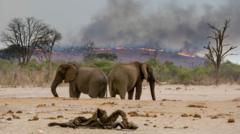A recent assessment indicates a 73% drop in average wildlife population sizes over 50 years, but the complex data demands nuanced understanding.
Global Wildlife Populations Face Severe Declines, Report Reveals

Global Wildlife Populations Face Severe Declines, Report Reveals
The Living Planet Index reports alarming reductions, but interpretation requires careful consideration.
The Living Planet Index has revealed a startling 73% reduction in the average size of monitored wildlife populations from 1970 to 2020. This biennial report, produced by major conservation groups, highlights a grave decline in populations of vertebrate species including mammals, birds, fish, amphibians, and reptiles. While this figure sounds alarming, it requires careful interpretation. Experts, such as Yale's Dr. Walter Jetz, caution against viewing the data as a universal measure of biodiversity loss, attributing the broad numbers to variability in population sizes and inconsistent dataset coverage. Despite its limitations, the Index is valued for spotlighting populations at risk and fostering further ecological study. Dr. David Murrell of University College London asserts that while the Index's calculations need refinement, it remains a crucial tool in understanding global wildlife trends. Ongoing debates about its methodology continue, with the Index's authors defending their approach amidst critiques of calculation bias.



















